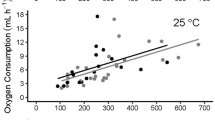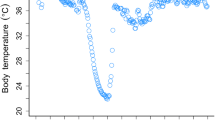Abstract
In ectotherms, an increase in body temperature increases metabolic rate and may increase rates of digestive processes. We measured the thermal dependence of the apparent digestive and apparent assimilation efficiencies (ADE and AAE), gut passage time (GP) and appetite in Cordylus melanotus melanotus, a medium sized Crag Lizard, which is endemic to South Africa. Trials were conducted at 20, 22, 25, 30, 32 and 35 °C under controlled conditions. Trials lasted 14 days, during which, lizards were fed ca. 1 g mealworms per day. Glass beads were used as markers to determine GP at the beginning and end of trials. Faeces and urates were collected daily and oven dried at 50 °C. The energy content of egested matter was then measured using bomb calorimetry. ADE and AAE were not affected by temperature for either males or females. The mean±SE ADE and AAE were 94.4±0.3% and 87.2±0.6%, respectively. GP was not significantly different between males and females at any temperature, but decreased significantly with increasing temperature. Appetite was significantly different between the different temperatures measured. The decrease of gut passage time with increasing temperature was expected, since the digestive and assimilation efficiencies are similar over the range of temperatures tested. Lizards are thus assimilating a similar proportion of ingested energy, but at faster rates at higher temperatures. The results indicate that the digestive physiology of this species results in maximum energy gain per meal in environments where food is scarce.






Similar content being viewed by others
Abbreviations
- AAE :
-
apparent assimilation efficiency
- ADE :
-
apparent digestive efficiency
- AE :
-
assimilation efficiency
- DE :
-
digestive efficiency
- GP :
-
gut passage rate
- NEA :
-
net energy absorbed through gut
- NER :
-
net usable energy retained
- SVL :
-
snout-vent length
- T b :
-
body temperature
References
Alexander GJ, Van Der Heever, C, Lazenby SL (2001) Thermal dependence of appetite and digestive rate in the flat lizard, Platysaurus intermedius wilhelmi. J Herpetol 35:461–466
Angilletta MJ (2001) Thermal and physiological constraints on energy assimilation in a widespread lizard (Sceloporus undulates). Ecology 82:3044–3056
Beaupre SJ, Dunham AE, Overall KL (1993) The effects of consumption rate and temperature on apparent digestibility coefficient, urate production, metabolizable energy coefficient and passage time in canyon lizards (Sceloporus merriami) from two populations. Funct Ecol 7:273–280
Bedford GS, Christian KA (2000) Digestive efficiency in some Australian pythons. Copeia 2000:829–834
Branch WR (1998) Field guide to snakes and other reptiles of Southern Africa (3rd edn). Struik, Cape Town
Cooper WE, Whiting MJ, Van Wyk JH (1997) Foraging modes of cordyliform lizards. S Afr J Zool 32:9–13
Du W-G, Yan S-J, Ji X (2000) Selected body temperature, thermal tolerance and thermal dependence of food assimilation and locomotor performance in adult blue-tailed skinks, Eumeces elegans. J Thermal Biol 25:197–202
Greenwald OE, Kanter ME (1979) The effects of temperature and behavioral thermoregulation on digestive efficiency and rate in corn snakes (Elaphe guttata guttata). Physiol Zool 52:398–408
Holmberg A, Kaim J, Persson A, Jensen J, Wang T, Holmgren S (2003) Effects of digestive status on the reptilian gut. Comp Biochem Physiol A 133:499–518
Hume ID (1989) Optimal digestive strategies in mammalian herbivores. Physiol Zool 62:1145–1163
Johnson RN, Lillywhite HB (1979) Digestive efficiency of the omnivorous lizard Klauberina riversiana. Copeia 1979:431–437
Lillywhite HB (1987) Temperature, energetics, and physiological ecology. In: Siegel RA, Collins JT, Novak SS (eds) Snakes: ecology and evolutionary biology. McGraw-Hill, New York, pp 422–477
McConnachie S, Whiting MJ (2003) Costs associated with tail autotomy in an ambush foraging lizard, Cordylus melanotus melanotus. Afr Zool 38:57–65
McKinon W, Alexander GJ (1999) Is temperature independence of digestive efficiency an experimental artefact in lizards? A test using the common flat lizard (Platysuarus intermedius). Copeia 1999:299–303
Mitchell HH (1964) Comparative nutrition of man and domestic animals, volume 2. Academic Press, New York, p 840
Moon S (2001) Pseudocordylus melanotus melanotus (Drakensberg crag lizard). Copulation and aggression. Herpetol Rev 32:258–259
Mouton PleFN, van Wyk JH (1993) Sexual dimorphism in Cordylid lizards: a case study of the Drakensberg crag lizard, Pseudocordylus melanotus. Can J Zool 71:1715–1723
Nagy KA (1983) Ecological energetics. In: Huey RB, Pianka ER, Schoener TW (eds) Lizard ecology: studies of a model organism. Harvard, Cambridge, pp 24–54
Naulleau G (1983) The effects of temperature on digestion in Vipera aspis. J Herpetol 17:166–170
Overgaard J, Anderson JB, Wang, T (2002) The effects of fasting duration on the metabolic response to feeding in Python molurus: an evaluation of the energetic costs associated with gastrointestinal growth and upregulation. Physiol Biochem Zool 75:360–368
Prosser CL, DeVillez EJ (1991) Feeding and digestion. In: Prosser CL (ed) Environmental and metabolic animal physiology: comparative animal physiology. Wiley-Liss, New York, pp 205–230
Ruppert RM (1980) Comparative assimilation efficiencies of two lizards. Comp Biochem Physiol A 67:491–496
Rutherford MC, Westfall RH (1986) Biomes of southern Africa—an objective categorization. Mem Bot Surv S Afr 54:1–98
Secor SM (2001) Regulation of digestive performance: a proposed adaptive response. Comp Biochem Physiol A 128:565–577
Secor SM, Diamond JM (1995) Adaptive responses to feeding in Burmese pythons: pay before pumping. J Exp Biol 198:1313–1325
Secor SM, Diamond JM (2000) Evolution of regulatory responses in snakes. Physiol Biochem Zool 73:123–141
Secor SM, Faulkner AC (2002) Effects of meal size, meal type, body temperature, and body size on specific dynamic action of the marine toad, Bufo marinus. Physiol Biochem Zool 75:557–571
Slade JH, Arnold WB, Plummer MV (1994) Efficiencies of digestion and assimilation in the gecko Hemidactylus turcicus. J Herpetol 28:513–514
Starck JM, Beese K (2001) Structural flexibility of the intestine of Burmese python in response to feeding. J Exp Biol 204:325–335
Starck JM, Beese K (2002) Structural flexibility of the small intestine and liver of garter snakes in response to feeding and fasting. J Exp Biol 205:1377–1388
Stevenson RD, Peterson CR, Tsuji JS (1985) The thermal dependence of locomotion, tongue flicking, digestion, and oxygen consumption in the wandering garter snake. Physiol Zool 58:46–57
Van Damme R, Bauwens D, Verheyen RF (1991) The thermal dependence of feeding behavior, food consumption and gut-passage time in the lizard Lacerta vivipara Jacquin. Funct Ecol 5:507–517
Waldschmidt SR, Jones SM, Porter WP (1986) The effect of body temperature and feeding regime on activity, passage time, and digestive coefficient in the lizard Uta stansburiana. Physiol Zool 59:376–383
Wang T, Zaar M, Arvedsen S, Vedel-Smith C, Overgaard J (2003) Effects of temperature on the metabolic response to feeding in Python molurus. Comp Biochem Physiol A 133:519–527
Acknowledgements
Gauteng Nature conservation granted permission to collect lizards for this study (permit no. 1143). The Animal Ethics Screening Committee of the University of the Witwatersrand cleared all experimental procedures (AESC 2001/27/2A and 2001/74/2A). The financial assistance of the National Research Foundation (NRF) towards this research is hereby acknowledged. Opinions expressed and conclusions arrived at are not necessarily to be attributed to the NRF. We thank Martin Whiting, Andrew McConnachie and two anonymous reviewers for useful comments and suggestions on this manuscript. This study was funded by grants to G.J. Alexander and M.J. Whiting from the National Research Foundation and the University of the Witwatersrand.
Author information
Authors and Affiliations
Corresponding author
Additional information
Communicated by G. Heldmaier
Rights and permissions
About this article
Cite this article
McConnachie, S., Alexander, G.J. The effect of temperature on digestive and assimilation efficiency, gut passage time and appetite in an ambush foraging lizard, Cordylus melanotus melanotus . J Comp Physiol B 174, 99–105 (2004). https://doi.org/10.1007/s00360-003-0393-1
Accepted:
Published:
Issue Date:
DOI: https://doi.org/10.1007/s00360-003-0393-1




